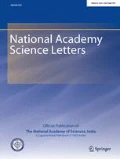Abstract
An actinobacterial strain designated as BN-6 was isolated from swallow bird mud nest by agar plate dilution method. It showed the morphological, physiological and biochemical characteristics of the genus Streptomyces. On the basis of 16S rRNA gene sequence analysis and physiological tests, this isolate was found to be most closely related with Streptomyces vinaceusdrappus NRRL2363. The strain BN-6 produced a broad spectrum active metabolite in Glucose Soybean meal (GS) medium and was extracted with HP Dianion resin. The resin extracted product showed activity against Gram-positive, Gram-negative bacteria, acid fast bacilli and fugal cultures, suggesting it broad spectrum characteristics. The bioautography on silica gel plates using Micrococcus luteus MTCC106 as test organism indicated the presence of a single metabolite having a Rf value of 3.2 and 9.1 in two different solvent systems. The characteristic peak obtained in UV–VIS spectrophotometer at 214 nm and chemical analysis indicates that it may be peptide class of metabolite.



References
Clardy J, Fischbach MA, Walsh CT (2006) New antibiotics from bacterial natural products. Nat Biotechnol 24:1541–1550
Fenical W (1993) Chemical studies of marine bacteria: developing a new resource. Chem Rev 93:1673–1683
Phoebe Jr CH, Combie J, Albert FG, Tran KV, Cabrera J, Correira HJ, Guo Y, Lindermuth J, Rauert N, Galbraith W, Selitrennikoff CP (2001) Extremophilic organisms as an unexplored source of antifungal compounds. J Antibiot 54:56–65
Brady SF, Chao CJ, Clardy J (2002) New natural product families from an environmental DNA (eDNA) gene cluster. J Am Chem Soc 124:9968–9969
Mukku VJ, Speitling M, Laatsch H, Helmke E (2000) New butenolides from two marine streptomycetes. J Nat Prod 63:1570–1572
Radhakrishnan M, Suganya S, Balagurunathan R, Kumar V (2010) Preliminary screening for antibacterial and antimycobacterial activity of actinomycetes from less explored ecosystems. World J Microbiol Biotechnol 26:561–566
Poulsen M, Oh D-C, Clardy J, Currie CR (2011) Chemical analyses of wasp-associated Streptomyces bacteria reveal a prolific potential for natural products discovery. PLoS ONE 6:e16763. doi:10.1371/journal.pone.0016763
Shomura T, Yoshida J, Amano S, Kojima M, Inouye S, Niida T (1979) Studies on Actinomycetales producing antibiotics only on agar culture. I. Screening, taxonomy and morphology productivity relationship of Streptomyces halstedii, strain SF 1993. J Antibiot 32:425–427
Kumar K, Bharti A, Gupta VK, Gusain OP, Bisht GS (2012) Actinomycetes from solitary wasp mud nest and swallow bird mud nest: isolation and screening for their antibacterial activity. World J Microbiol Biotechnol 28:871–880
Kumar V, Gusain O, Thakur RL, Bisht GS (2012) Isolation, purification and partial characterization of an antimicrobial agent produced by halotolerant alkaliphilic Streptomyces sp. EWC 7(2). Proc Natl Acad Sci India Sect B Biol Sci 83(2):199–206. doi:10.1007/s40011-012-0117-y
Bauer AW, Kirby WMM, Sherries JC, Turck M (1966) Antibiotic sensitivity testing by a standardised single disk method. Am J Clin Pathol 45:493–496
Bisht GS, Bharti A, Kumar V, Gusain O (2012) Isolation, purification and partial characterization of an antifungal agent produced by salt tolerant alkaliphilc Streptomyces violascens IN2-10. Proc Natl Acad Sci India Sect B Biol Sci 83(1):109–117. doi:10.1007/s40011-012-0086-1
Odakura Y, Kase H, Itoh S, Takasawa S, Takahashi K, Shirahata K, Nakayama K (1984) Biosynthesis of asatromicin and related antibiotics. II. Biosynthetic studies with blocked mutant of Micromonospora olivasterospora. J Antibiot 37:1670–1680
Williams ST, Sharpe ME, Holt JG (1989) Bergey’s manual of systematic bacteriology, vol 4. Williams and Wilkins, Baltimore
Shilrling EB, Gottlieb D (1968) Cooperative description of type cultures of Streptomyces III. Additional species descriptions from the first and second studies. Int J Syst Bacteriol 18:279–392
Shilrling EB, Gottlieb D (1969) Cooperative description of type cultures of Streptomyces. IV. Species descriptions from the second, third and fourth studies. Int J Syst Bacteriol 19:391–512
Motta A, Brandelli D (2002) Characterization of an antimicrobial peptide produced by Brevibacterium linens. J Appl Micrbiol 92:63–70
Kurusu K, Ohba K (1987) New peptide antibiotics LI-FO3 and characterization. J Antibiot 40:1506
Motta A, Brandelli D (2002) Characterization of an antimicrobial peptide produced by Brevibacterium linens. J Appl Micrbiol 92:63–70
Kurusu K, Ohba K (1987) New peptide antibiotics LI-FO3, FO4, FO5, FO7 and FO8, produced by Bacillus polymyxa. Isolation and characterization. J Antibiot (Tokyo) 40:1506–1514
Acknowledgments
The authors V. Kumar and G. S. Bisht are thankful to Uttarakhand State Council for Science and Technology (UCOST), Government of Uttarakhand, India (File No. UCS &T/R&D/LS/06-07/1158) for providing financial support, and to the Wadia Institute of Himalayan Geology, Dehradun, India for providing scanning electron microscopy facilities.
Author information
Authors and Affiliations
Corresponding author
Electronic supplementary material
Below is the link to the electronic supplementary material.
Rights and permissions
About this article
Cite this article
Kumar, V., Naik, B., Gusain, O. et al. Taxonomy and Antimicrobial Activity of an Actinomycete Strain Isolated from Swallow Bird Mud Nest. Natl. Acad. Sci. Lett. 38, 387–391 (2015). https://doi.org/10.1007/s40009-015-0379-z
Received:
Revised:
Accepted:
Published:
Issue Date:
DOI: https://doi.org/10.1007/s40009-015-0379-z

